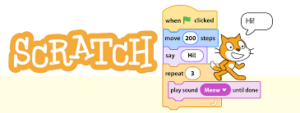Book a FREE Trial
See why Code Galaxy is the #1 online coding
school of choice for students & parents.

Scratch stands as a beacon in the world of educational technology, offering children a simplified yet comprehensive introduction to the fundamentals of coding. Through a user-friendly interface, it enables them to develop games, interactive stories, and animations, fostering creativity and logical reasoning in the process.
Scratch has captured the interest and imagination of millions around the globe. But what is the story behind Scratch? Who created it and why? What features does it offer to young learners, and how has it reshaped learning paradigms globally? This article seeks to unpack the origins, features, and impact of Scratch, offering readers a deep dive into a platform that has become synonymous with children’s coding education worldwide.
In the early 2000s, the world witnessed the birth of a revolutionary educational tool that would change the landscape of learning for young minds globally: Scratch. Behind this innovation was a team of forward-thinkers and educators who sought to make the coding world accessible and enjoyable for children.
At the heart of Scratch’s creation was Mitchel Resnick, a notable professor at the Massachusetts Institute of Technology (MIT). Resnick wasn’t just an educator; he was a visionary who recognized the need for a learning platform that resonated with the natural curiosity and explorative nature of children.
Guided by the philosophy of “learn to code, code to learn,” Resnick conceptualized Scratch as more than just a tool to acquire technical skills. He envisioned a haven where children could learn through play, fostering creativity, and nurturing logical thinking. In his eyes, learning to code was not an end but a means, a medium to encourage young minds to think innovatively and solve problems with a critical eye.
But Resnick’s vision went beyond just creating a platform. He dreamt of cultivating a community where children could collaborate, share ideas, and grow together, building not just coding skills but essential life skills like cooperation, communication, and persistence.
To bring this vision to life, Resnick collaborated with the Lifelong Kindergarten Group at the MIT Media Lab, a powerhouse of researchers and educators committed to rethinking learning through playful experiences. This group became the bedrock of Scratch, bringing together knowledge from various fields, including education, psychology, and computer science, to create a platform grounded in holistic learning.
Under the aegis of the MIT Media Lab, Scratch started taking shape, evolving from a mere concept to a tangible platform that embodied a perfect amalgamation of fun and learning. The goal was simple yet profound: to craft a learning environment that encouraged kids to be creators, not just consumers, igniting their imagination and empowering them with the skills to bring their ideas to life.
Together, Mitchel Resnick and the Lifelong Kindergarten Group turned Scratch into a reality, creating a platform that has since blossomed into a vibrant community of young learners eager to explore, create, and share in the colorful world of coding.

See why Code Galaxy is the #1 online coding
school of choice for students & parents.
As Scratch navigated its journey from a visionary concept to a concrete reality, a range of features were developed to facilitate a fruitful and enjoyable learning experience. These features have not just removed the barriers to coding for young learners but have also cultivated a rich environment where creativity and collaboration thrive.
The Scratch platform stands as a testament to ingenuity and innovation, designed to cater to the imaginative minds of young learners. Here are some of its standout aspects:
Beyond the individual features that facilitate easy learning and creation, Scratch extends into a vibrant, global community that fosters collaboration and sharing. Here’s how:
Since emerging from the fertile grounds of innovation at the MIT Media Lab, Scratch has been on an upward trajectory, constantly reinventing itself to cater to the young generation. Here we break down the phases of its growth:
As we gaze into the future, it is clear that Scratch has a bright path ahead, armed with a mission to continue inspiring budding creators. Here’s a glimpse into what the future might hold:
Are you looking to introduce your child to the fun and educational world of Scratch? Code Galaxy is here to help with online classes specially made for young learners. These classes are a fun way to help kids become young creators, using Scratch to build their own stories, games, and much more.
The classes are easy to follow, making learning a breeze for your little one. And the best part? You can try it out with no risk, thanks to Code Galaxy’s free trial offer. So why wait? Sign your child up for a free trial today and take the first step in nurturing a young, creative mind.
See why Code Galaxy is the #1 online coding
school of choice for students & parents.